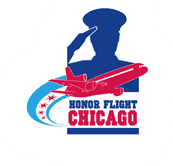Navy Vietnam War St. John, IN Flight date: 05/14/25
By Al Konieczka, Honor Flight Chicago Veteran Interview Volunteer
David had a very diverse and convoluted first 26 years of his life. David was born at St. Margaret’s Hospital in Hammond Indiana while his family hailed from Lansing, Illinois. When David was just 7 years old, his mother died from complications during child birth. There were eight children in his family and David’s father was simply not equipped to take care of 8 children on his own.
David’s father had a sister and brother-in-law who lived in North Dakota. David and his next youngest brother were sent to North Dakota to live with them. After four years living with his aunt and uncle, David and his brother were adopted, and his aunt and uncle became his step-parents. Even though David and his brother went to live in North Dakota, he still kept in touch with his other siblings.
When David was about 15 years old, his new step-father, bought a farm in southern Minnesota and the family relocated. David would complete his education and graduate high school in Minnesota. David did a lot of animal care on the farm. They had milking cows, some beef cattle, a few horses and a lot of pigs. While on the farm, David operated tractors, hay bailers and harvesters not only on his farm but also for other local farms in the area.
When David graduated high school he started working at a local manufacturing company that made automated chicken feeding equipment. “They made all the cages, all the troughs, the augers and the bins. I was involved with all the different departments doing more mechanical stuff. They even had a tool and die department and I worked in there for a little bit so I got a little knowledge there too. I also got into truck driving when I started delivering materials to different farms in the area.”
David attended a local junior college for a year and a half, although he admitted his grades were not very good while in school. David was drafted in April of 1967. I asked David why he chose the Navy. “I didn’t want to go into the Army. I went to the Air Force recruiter and they weren’t taking anyone. So I went to the Navy recruiter and took some aptitude tests. During my initial testing, the Navy thought I was a good candidate for nuclear power school. But in order to be in nuclear power school you had to agree to enlist for two additional years (so a total of six years) beyond my initial four year commitment.” David agreed to sign up for the total package. He joined under the Navy’s 120 day delay program so he didn’t have to go to boot camp right away. The Navy’s 120-day delay program, also known as the Delayed Entry Program (DEP), allowed individuals to enlist in the Navy and then postpone their active duty for a period of time, typically 120 days. This delay was often used to allow individuals to complete their high school education or other personal goals before starting their active duty.
In September of 1967 David went to Boot Camp in San Diego. He spent eight weeks there before heading off to A School at Great Lakes for four months training as a machinist’s mate. In the Navy, A School refers to the initial technical training program sailors attend after boot camp to learn the skills required for their specific job or rating. Great Lakes Naval Station housed numerous “A” schools, also known as rating training schools, for various Navy specialties. These schools provide specialized training for enlisted personnel in specific areas like electrical engineering, electronics, and damage control.

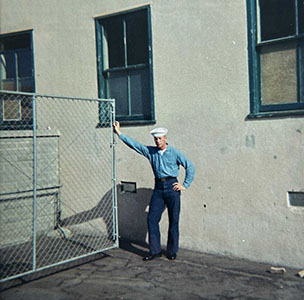
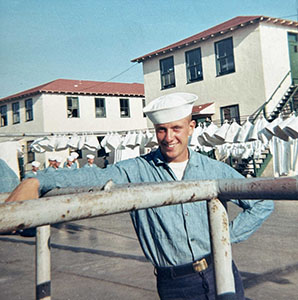
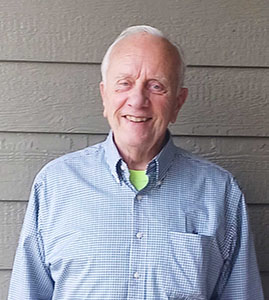
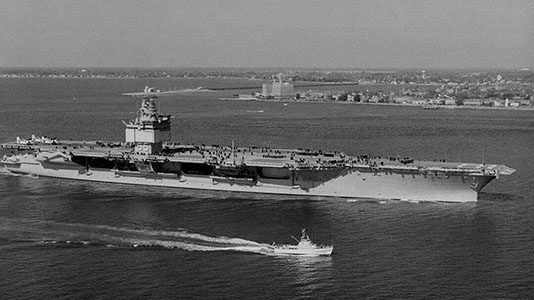
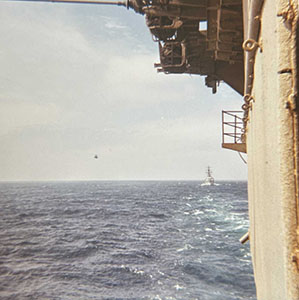
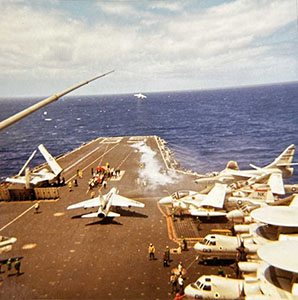
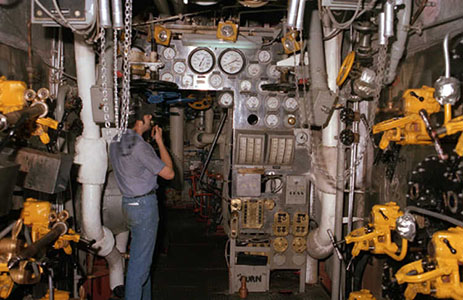
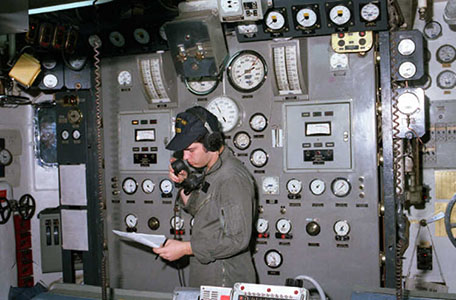
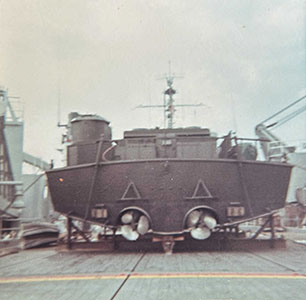
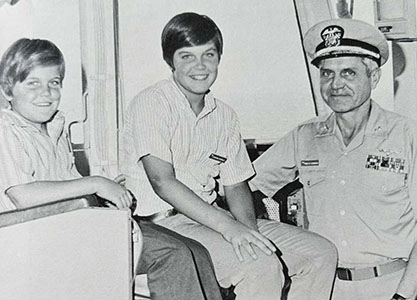
From A School David headed to a ship in Little Creek Virginia, the USS Spiegel Groeve (LSD 32) which was an amphibious base. “I was on that LSD, what they call a landing ship dock for six months while I was waiting for my nuclear power school class to start. The six months I spent on the Spiegel Groeve were very interesting. Being a farm boy, and then going out to the big ocean, it was a very different experience. Once we went to Woods Hole, Massachusetts and picked up a deep diving submarine named Alvin. With our LSD, you could ballast down the stern, drop the stern gate, float another boat inside and the close the stern gate and pump out the well deck and work on it. We travelled to the Azores with Alvin to look for an American nuclear submarine named The Scorpion that had sunk.”
David was in the Azores about two months with that deep diving sub but never did find the Scorpion. Three months later, the Navy located the wreckage of the Scorpion in eleven thousand feet of water about four hundred miles southwest of the Azores. David admitted that his time on the USS Spiegel Groeve was a very fun six months. “We went down to Fort Lauderdale one time for the Reynolds Aluminum Company. They had a deep diving aluminum submarine they called the Aluminaut. We brought that sub down to the Virgin Islands and dropped it off. The Spiegel Groeve was more like a transporter vessel. It was a very interesting six months of my life.“
After his tour on the USS Spiegel Groeve, David headed off to nuclear power school in September of 1968 for six months. David laughed and shared with me, “When I was in nuclear power school in Bainbridge, Maryland, the class was filled with lots of braniac students and I certainly wasn’t one of them. But through all the class activities and testing, I ended up with a 3.67 GPA out of a 4.0, but I was still towards the bottom of the class. It was very intense. We had testing every single day. And at the time, in the early 1960’s nuclear power was brand new. There were only four surface ships that were nuclear powered in the entire world at that time.”
At the conclusion of nuclear power school David went to a prototype nuclear facility in the Idaho desert for six months. It was a national reactor testing station and the Navy had three prototypes there with different nuclear power plants in use at the time. One prototype was a submarine, one an aircraft carrier and one was for a destroyer.
The Navy started David on the submarine prototype and then decided to send him to submarine school in Connecticut. After six weeks in submarine school he was escorted to one of the submarines there at the base, but he really didn’t like it. “I was scheduled to be a diver and an underwater welder but that still wasn’t enough to entice me to want to be on a submarine. Since it was a volunteer program, I thought the only way to get out of it was to drop my grades. Unfortunately they caught on pretty quickly to what I was doing because I had been testing very well and then all of a sudden I stopped doing well.”
The Navy kicked David out of the submarine program and assigned him to the USS Wasp, which was an older World War II era aircraft carrier. He served on that ship for a year. For David, his assignment to the Wasp was really more or less a test to see if he was a delinquent or if he really knew what he was doing.
David told me, “We went across the Atlantic three times during my year on the WASP. One time we ended up in the Mediterranean and we went to Barcelona and a couple other spots in Spain. We also went to Northern Europe and joined some NATO forces and did some exercises up there and in the process we ended up in the Arctic Circle sailing through a slushie.”
After a year on the Wasp, David finally received orders for the USS Enterprise in May of 1971. When he first got to the Enterprise, he underwent even more testing and within two weeks he was on his way to Vietnam. He had to become familiar with the ship, all the systems, perform more classroom work and more hands on training and he did very well with all of it. In fact, David made the rank of E-6 in less than four years which is unheard of in the Navy.
David’s first duties after he qualified for watchstanding were to be in the engine room while it was operating for a shift of anywhere from 4-8 hours. He would soon advance his way to become a supervisor and chief mechanical operator responsible to monitor and maintain operations, ensuring the ship ran smoothly and safely. David said, “It’s hard to describe how the engine room operates but it’s basically all pumps pumping water and pumping steam. Everything was steam operated. All the electricity for the ship was generated by a steam generator.”
David enjoyed working in the engine room despite the temperature never being under 100 degrees. “We had blowers in there but no air conditioning. If you got too hot, you would stick your head inside a blower for a few seconds of relief and then get back to work.” David especially enjoyed his time off the coast of Vietnam. “There were a lot of speed and direction changes in the combat zone. That meant a lot of stuff going on in the engine room. I look back today and think how the heck did I do that. I was a 25-year-old kid in charge of a half dozen people running an engine room during combat operations on a multi-million dollar ship. But I did it!“
The Enterprise had four engine rooms and was the only carrier that had eight nuclear reactors. “We would get an engine order from the bridge to go a little faster. And of course everything was measured in terms of propeller RPMs. For example, they would want 20 knots and 180 rpms on the propeller. So realize that all four engine rooms had to coordinate any speed and direction changes at the same time so the ship would act appropriately. And the reactor operators were in a completely different room. So they would have to increase the power to the reactor. Then the throttle guy would have to increase the steam going to the main turbines, which may involve a different pump configuration pumping more water to the reactor to create more steam. If one engine room had a problem there were ways to share steam from one engine room to another. It was a very big and involved process.”
David told me that the ship was always in motion until they came to a destination port. The ship operated 24/7. Even when in port they had to generate their own power. There were some ports that weren’t deep enough so they would have to drop anchor outside the port. During his time on the Enterprise, David said they did suffer a few casualties. “We lost a few pilots over North Vietnam. We had several incidents where guys got knocked overboard by the jet blast or if they were just careless. If they fell overboard, they got sucked under the ship and they were gone. There were also several times where we had to race to a freightliner in the area that had caught fire and people were in lifeboats and we had to rescue them.“
David described the noise aboard the Enterprise. “Our sleeping quarters were seven decks below the flight deck but when planes landed, it sounded like they were right next to you. You could hear them hit the deck and snag that cable and the machinery involved with that cable was so noisy it was a very high pitched screech. Then it would retract as the cable bounced along the flight deck. I can still hear that noise in my head to this day.”
David spent 2 ½ years on the USS Enterprise until he was discharged in September of 1973. During his time on the Enterprise, the carrier was sent to Vietnam twice so he spent a total of 20 months off the coast of Vietnam. Towards the end of David’s service in the Navy while still off the coast of Vietnam, the ship received a slight extension. When the peace accord was finally signed on January 27, 1973 the Enterprise was just cruising around the area waiting for the release of several POWs.
They finally were given orders and picked up five Navy officer POWs who were flown to the USS Enterprise. One of those POWs was Navy Vice Admiral James B. Stockdale, an iconic Naval aviator who remains the only three-star admiral to have worn both aviator wings and the Medal of Honor. The POWs were transported by the Enterprise to Pearl Harbor. David reflected on that mission, “At the time I was just a stupid kid and I didn’t keep track of national or world events. But now as I look back to that day, that was probably the most interesting experience I had while on the Enterprise.” The four other POWs transported aboard the USS Enterprise alongside Navy Vice Admiral James B. Stockdale were Jeremiah Denton, George McKnight, Harry Jenkins, and Sam Johnson. They were part of a group of 11 US military prisoners known as the “Alcatraz Gang”.
David was discharged in Washington State at the Navy shipyard on Puget Sound and drove home in his ’69 Chevy Camaro. After his discharge, he contacted his older brother who owned a construction company and he went to work for him. He became a member of the International Union of Operating Engineers Local 150 and worked in the construction industry for 42 years. “I did a lot of underground work with sewer and water construction. I did building demolition and a lot of excavating. I worked on a job once at the University of Chicago and was 36 feet deep underground because the building had multiple basements in it. So my whole life has been hands on mechanical stuff.”
David and his wife Margie met on Memorial Day at a church pig roast less than a year after his discharge. They have been married for 49 years and have four children, eleven grandchildren and two great grandchildren. David enjoys reading, especially American history, and is also active with his church helping to build wheelchair ramps and other structures helping people enjoy a better quality of life.
David, thank you very much for your dedicated service and please enjoy your well-deserved trip to Washington D.C.!

